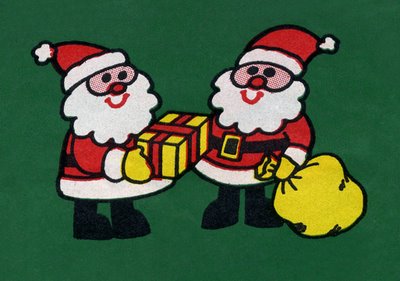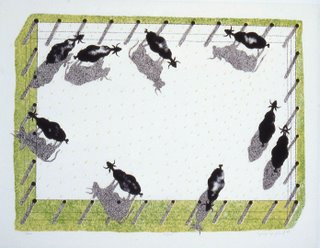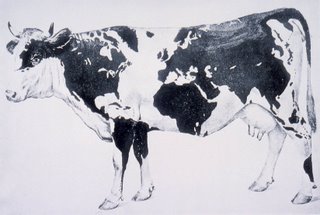Art and the Gift Economy: a couple of Stocking Stuffer Gift books.
With most artists living a life of precarity, the idea of the Gift has been examined as a way of understanding the motivation of artists as well as their relationship to the community and economy. The positions presented range from regarding ‘Art’ as existing as a
philosophical attitude outside the market system, to its role as a player in a Gift Economy – and many states between.
There seem to be three main areas where Gift economies are discussed. One is in social anthropology, a second is in evolutionary biology and the third is in art.
Reciprocal altruism exist in the natural world, and while the adjective, “reciprocal”, implies a trade economy, the motivation for such behaviour is unlikely to be conscious, calculated self interest, as many of the life forms exhibiting these altruistic acts (ants for example) are assumed to be incapable of the necessary level of cognitive ability for cynical decision making. So we must be observing genetic coding being expressed, mechanically on the one hand, or through emotion and desire on the other. In other words generosity and altruism can be seen in many higher species as intrinsic characteristics linked to positive emotions. We give because we experience joy in doing so. Remembering of course that as with all human behaviour, we are looking at complex and often contradictory determinants.
“If men were as much men as lizards are lizards, they would be worth looking at” -– D.H. Lawrence
Why do we then decide that all giving is cynical and calculated (some no doubt is), and must be part of an all-encompassing market system. Who would want us to think that?
Can we not attribute value without considering its tradability? Valuing the giver not the price of the gift?
We give for the joy of giving – outside the world of accountancy.
“It must have been a gift - I got nothing back – how kind of me.”
Germs on Art“The true field of art is the mind of the beholder; what is being worked on is the relation of the beholder to his perception of reality, of duration, relativity, acceptance, rejection, alienation. The artist positions you in a dark room and turns the light on, and off again. He does no more because there is no need to do more. In finding yourself equal to the encounter, you are empowered with the artist's own intellectual energy. For the time you are together, you are sharing the same cerebral space. Best of all, you can only remember it. You can't collect it………….. Perhaps we should begin to think in terms of ensuring that our young artists are free to work, and have space to work, by paying for them rather than their product.” – Germaine Greer.
Stocking Stuffer Gift Book #1.
The Gift (1925) Marcel Mauss.
David Graeber, a professor of anthropology at Yale University writing on
the great early-20th century French sociologist Marcel Mauss’ most famous work, The Gift.
“The universal assumption of free market enthusiasts, then as now, was that what essentially drives human beings is a desire to maximize their pleasures, comforts and material possessions (their "utility"), and that all significant human interactions can thus be analyzed in market terms.”
The idea for MAUSS (Mouvement Anti-Utilitariste dans les Sciences Sociales) was born in 1980. The project is said to have emerged from a conversation over lunch between a French sociologist, Alain Caillé, and a Swiss anthropologist, Gérald Berthoud. They had just sat through several days of an interdisciplinary conference on the subject of gifts, and after reviewing the papers, they came to the shocked realization that it did not seem to have occurred to a single scholar in attendance that a significant motive for giving gifts might be, say, generosity, or genuine concern for another person's welfare. In fact, the scholars at the conference invariably assumed that "gifts" do not really exist: Scratch deep enough behind any human action, and you'll always discover some selfish, calculating strategy. Even more oddly, they assumed that this selfish strategy was always, necessarily, the real truth of the matter; that it was more real somehow than any other motive in which it might be entangled.”
Social anthropology analyses many exotic societies with so called gift economies. But our own system, as it is calculated for purposes of financial and political budgeting, is based on an un-costed gift economy; the voluntary and charity sector. It has been estimated that close to 50% of the total national economy is made up of gifted goods and services.
This “grey” economy is operated by volunteers who give their time and money to make social welfare, health, sport, culture, civic life, etc., possible at home, and survival possible in other parts of the world. Sometimes living precariously themselves, they make up that part of the economy that market systems exclude from their accounting – thus making the arguments for a market based global economy something of a sham. Similarly in local political discussions about water and carbon trading (using the market to save the environment), the costs of ground water and carbon emissions are based on partial information and are therefore likely to be grossly underestimated. It is not in the interests of short term profitability to do complete long term environmental costing.
“Polanyi, whose major work is called The Great Transformation, is really an ecological thinker. He shows how the notion of the self-regulating market, which is supposed to assign a proper price to everything and thereby secure the necessary resources for the continual production of an ever-expanding
range of goods, fails tragically to account for all the factors involved in the reproduction of land, of labor, and of the very institution of exchange, money itself…
..Unconventional and dissenting ideas don't often come out of established and conventional functions. And when everybody tacitly agrees that cultural production can only take place under the beneficent gaze of the market and the state, and on their payrolls, what you get in my opinion is very dull and timid attitudes combined with grotesquely simulated and overblown emotions. Or, from the more ambitious and professional types, you may get hyper-specialized discourses and elaborate aesthetic affects.” –
Brian HolmesStocking Stuffer Gift Book #2.
The Gift, Lewis Hyde.
Hyde’s basic premise runs along the lines of what he calls a system of gift economy. Art is not a commodity, he says. It cannot be valued according to principles of commerce. Rather, the spirit of the work, its independence and individuality, its very essence, can remain active only if the gift of art is kept in circulation – shared, passed on. The minute art is bought or sold in the traditional sense that merchandise created for a market is bought and sold, it becomes nothing more than another pair of shoes, or a dinner service. – Kirsty Gunn, in
Art is most precious when it’s free.
The Art of Giving. Last words to Bruce Barber from his writings on Litttoral Art.
Bourdieu's logic of practice privileges individual agency, in all its unpredictability and contrariness, as the primary component of a generative model of giving (and understanding). Perhaps this logic of practice, like that promoted by Habermas himself "provides an alternative to money and power as a basis for societal integration." And without an acknowledgement of individual agency within communicative action, that is of the potential for contrariety - the act of giving, the gift of food, the gift of labour, the gift of
blood, and of life itself, would seem valueless.












